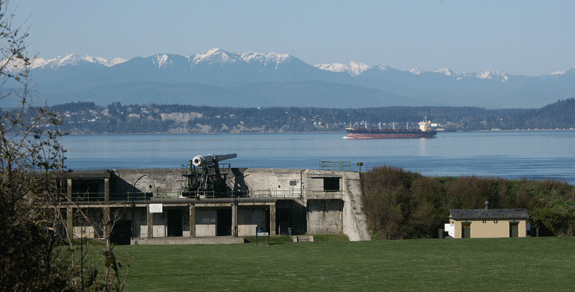History of America’s Seacoast Defenses
U.S. Army Coast Artillery and the Harbor Defenses of the United States

A 10 inch seacoast artillery gun on a disappearing carriage at Fort Casey State Park overlooks the Puget Sound (photo by Steven Kobylk, 2006)
From it’s formation in 1784, The United States of America had to consider its defense against seaborne attack. While a citizen army could repel invasion, assembling such an army at the point of attack would take time. The US Government recognized the need to defend vulnerable points against sudden attack and to buy time for the nation to assemble its manpower. The result was an acknowledgement that America needed permanent fortifications to protect her seaports. While virtually every nation recognized the superiority of forts over ships and relied on fortifications to protect their harbors, the United States took to them with particular enthusiasm.
Seacoast artillery is now a part of American history. Their scenic locations near large cities have made these defenses visible to many casual visitors. The nature of fortifications, their permanence and resistance to destruction, has allowed them to withstand both natural elements and economic development. Among the most prominent surviving artifacts of American military history, they continue to inspire public interest. This interest, however, is seldom matched by available information. Far too many visitors leave with no clear understanding of the forts, when they were built, or how they functioned. The Coast Defense Study Group’s (CDSG) programs and this website will assist in greater understanding of this important military history.
The U.S. Army’s Coast Artillery Corps defended the United States against naval attack with fixed gun and controlled mines defenses located around major deep-draft harbors. Seacoast harbor defense fortifications during the Modern era was a complex system of gun batteries, fire control stations, communications bunkers, wharves, searchlights, and minefield control structures, as well as cantonment areas with enlisted barracks, officers’ quarters, hospitals, post exchanges, bakeries, power plants, and ordnance & supply storage buildings. This website provides information on the various elements that made up a harbor defense in a general form in the links below. For specific examples of information available on the forts and gun batteries visit the CDSG webpages for:
Harbor Defenses of the Columbia River
Harbor Defenses of the Puget Sound.
Here is a link to an audio recording of the 1934 Coast Artillery march “Crash On Artillery”: https://archive.org/details/78_crash-on-artillery-coast-artillery-marching-song_victor-military-band-the-four-c_gbia0055878/04+-+Crash+On!+Artillery+(Coast+Artiller+-+Victor+Military+Band.flac
